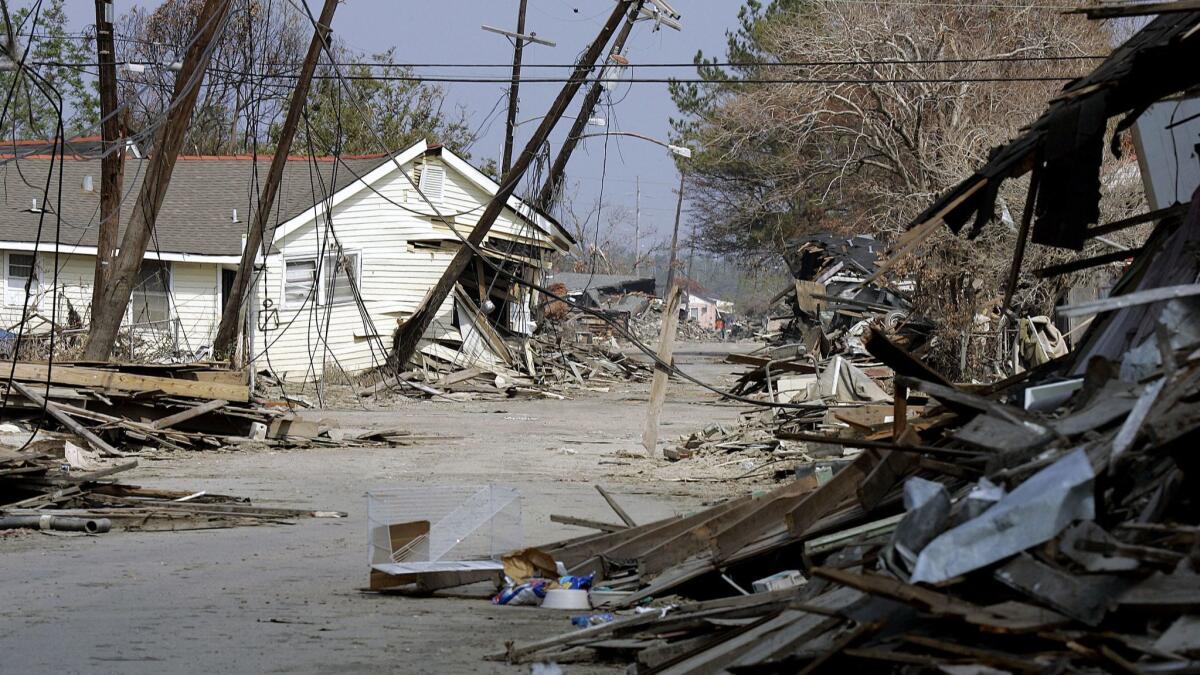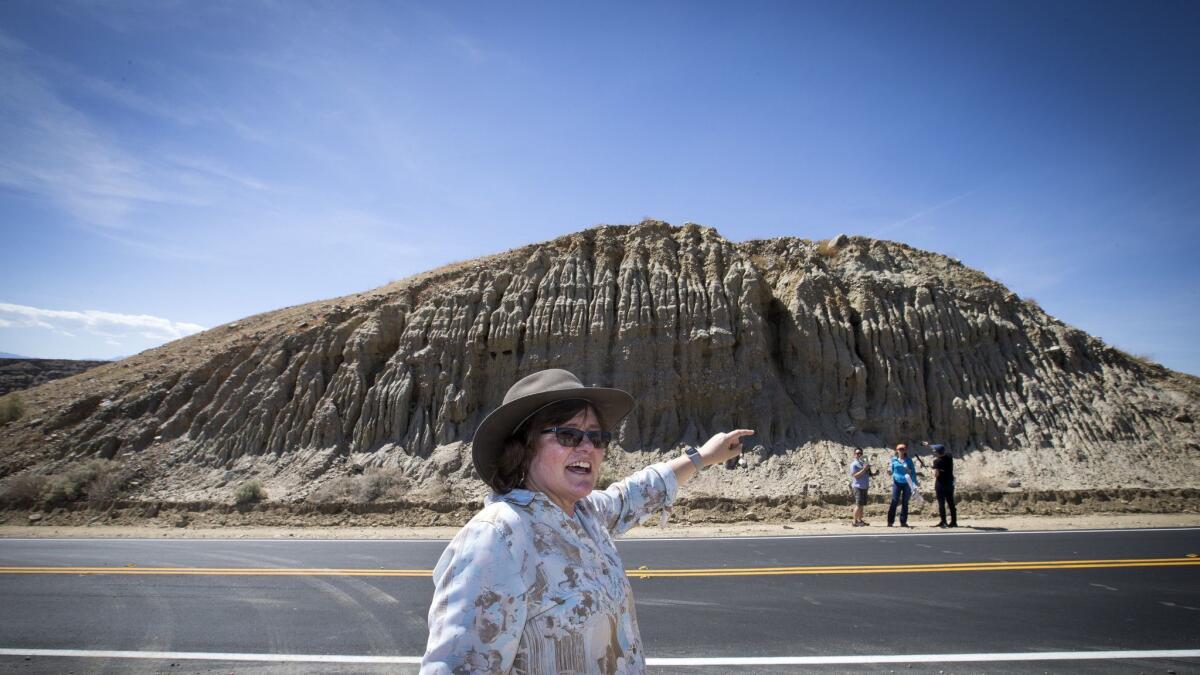The big one is coming to California, seismologist Lucy Jones says cheerfully
- Share via
“I’m an inherent optimist,” says earthquake expert Lucy Jones. Sitting in her bright, tidy office at Caltech, the world-renowned seismologist does not betray a shred of irony at this admission, despite how surprising it may seem coming from a woman who asserts in no uncertain terms that Southern California is headed for a devastating magnitude 7.5 to 8.2 earthquake — it’s only a matter of time, she says.
Her new book “The Big Ones: How Natural Disasters Have Shaped Us (and What We Can Do About Them)” shares Jones’ unlikely combination of realism and optimism. “Natural hazards are inevitable,” she writes, “the disaster is not.” It’s up to us, she explains, to prevent and mitigate disaster, overcome our fear of the unknown, engage with policy makers and connect with one another.
By writing this book, she says, “I’m trying to empower people,” tracing the lessons learned from human error — and triumph — in response to earthquakes, volcanic eruptions, tsunamis and floods. Organized chronologically, the book moves from Pompeii in the year 79 to Tohoku, Japan, and the Fukushima nuclear disaster in 2011.
For years, when any part of the earth shook, the media called Jones, who holds a doctorate in geophysics. “Why talk to a seismologist after an earthquake anyway? I’m not going to help you rebuild your house. None of my information really connects to how the earthquake directly affected you,” she says. “But I give it a name and I give it a number and I give it a fault and I make it understandable. There’s that deep, desperate need” to quell our fear of randomness, she says, to find pattern and meaning in events — to find story. “It gives it a narrative,” a fundamentally human way of understanding the world.

“The Big Ones” examines thrust faults and subduction zones; it also considers psychology and evolution. “It was an interesting process internally to empower myself to talk about something that’s not my academic field,” she explains. “I’ve now said I’m not just a scientist, I’m a storyteller, and I have emotional lessons from this life to share.”
In writing about Lisbon’s All Saints’ Day earthquake of 1755, which killed roughly 60,000 people, Jones imagines the fires it sparked, devotional candles “setting flame to carved wooden statues, embroidered altar clothes, old prayer books.”
“When you write science, it’s all logical argument,” she says, “you never tell a story.” This book, on the other hand, is another matter. “I could see how I changed in the year of writing...Each time I brought in something human, I realized how much that added.”
Jones retired two years ago from the U.S. Geological Survey; she is currently a research associate at Caltech and leader of the Dr. Lucy Jones Center for Science and Society. She wrote the book at home, “in a lovely sunroom looking over the garden,” taking breaks to practice the viola de gamba, which she picked up in college. (“Professional seismologist and amateur musician seemed a better combination than the alternative,” she says.) She was grateful for the solitude.
“I needed it so desperately. It may not be obvious when I do all this TV stuff, but I’m fundamentally an introvert,” she says.
“My career is this evolution from pure science to gradually taking on more and more policy and social stuff because the need was there,” she says, “and that’s the way the book ends up growing, too.”
It is, still, a chronicle of disasters. A chapter on the Great Mississippi River Flood of 1927, which Jones wrote in the aftermath of Ferguson, documents the abuse faced by African American refugees in relocation camps. “When I got to [writing about] Katrina, it was such a mirror of Mississippi,” Jones says. She describes the New Orleans disaster as an object lesson in scapegoating, in which victims were blamed.
“We must remember the most dangerous threat in a disaster is the threat to our humanity,” writes Jones, and yet, ever the optimist, her book arcs toward progress. The Sumatran tsunami, in 2004, “was the world’s first truly global disaster,” with victims from 57 countries. “Pictures of the devastation traveled around the world faster than the tsunami itself,” she writes. Globalization meant that Sumatra touched people all over the world, generating empathy and “humanity’s expansion of the definition of ‘us’.”
Jones chose to include only one Southern California disaster in her book — no, not the 1994 Northridge quake but 1861-62’s Great Flood, which affected the entire state. “To have my only California disaster be the flood helped make the point about how we’ve forgotten,” she says. A fourth-generation Californian, Jones herself only learned of the flood in 2010.
Furthermore, floods just don’t factor into our collective imagination the same way as earthquakes, which are as much a part of Los Angeles’ collective identity as Hollywood or the Santa Ana winds. Earthquakes contribute to “the sense of impermanence,” says Jones, in a city of transplants and transients and reinvention. Just north of her office, the San Andreas Fault pushes up the San Gabriel Mountains — slowly, imperceptibly reinventing the landscape itself.

To prevent disaster, we’ll need to confront that reality. In “The Big Ones,” Jones presents the history of natural disasters as the history of ourselves; looking back as a way to look forward.
Of the 2011 Tohoku earthquake, she says, “I found those women in Japan so personally inspiring.” She interviewed survivors who were organizing relief efforts. “To watch them not just suffer through that much and move on but to make something new out of it, to open up opportunities.” As Jones described their bravery and conviction — teaching children how to measure radiation and recognize safe places to play — she wiped away tears.
After a moment, she asks, “The future of L.A., what are we going to make of it?”
Lucy Jones appears 10:30 a.m. Apr. 21 at the Festival of Books on the panel The Environment on the Precipice with Dan Egan (“The Death and Life of the Great Lakes”) and Edward Struzik (“Firestorm: How Wildfire Will Shape Our Future”), moderated by Teofilo Ruiz.
More to Read
Sign up for our Book Club newsletter
Get the latest news, events and more from the Los Angeles Times Book Club, and help us get L.A. reading and talking.
You may occasionally receive promotional content from the Los Angeles Times.











